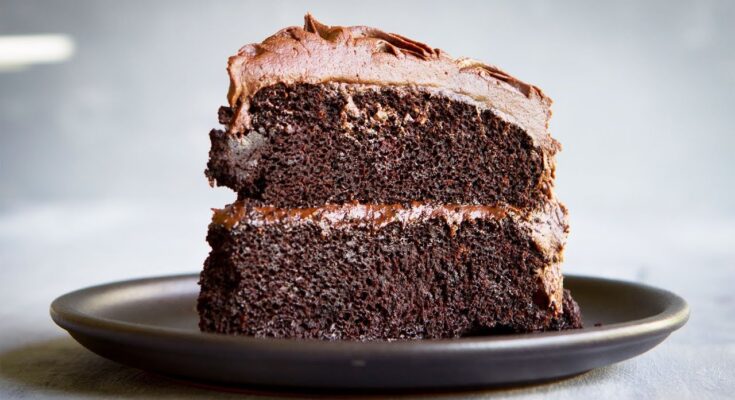Vegan Cake Recipe: Baking a delicious cake without dairy or eggs might sound like a challenge, but once you master a solid vegan cake recipe, there’s no going back. Vegan baking is not only healthier and cruelty-free, but it also offers just as much flavor and satisfaction as traditional baking—sometimes even more! Whether you’re a full-time vegan, baking for someone with allergies, or just exploring plant-based options, learning how to bake a vegan cake is a must-have skill in your kitchen.
Vegan cakes are made without any animal products—no butter, no milk, and definitely no eggs. But don’t worry, that doesn’t mean sacrificing texture or taste. With the right techniques and ingredients, you’ll create moist, fluffy, and flavorful cakes that everyone will love. Ready to get started? Let’s dive into the essentials first.
Essential Vegan Baking Ingredients
To bake the perfect vegan cake, you’ll need to stock your kitchen with some essential plant-based substitutes. The good news is, many of these ingredients might already be in your pantry. And if not, they’re easy to find at most grocery stores.
Egg Substitutes:
Eggs typically add structure, moisture, and richness to a cake, but you can replace them with:
- Flaxseed Meal: Mix 1 tablespoon flaxseed meal with 3 tablespoons of water to replace one egg.
- Chia Seeds: Use 1 tablespoon chia seeds and 3 tablespoons water for a gel-like consistency.
- Applesauce: ¼ cup of unsweetened applesauce equals one egg and adds moisture.
- Mashed Bananas: Great for flavor and texture, but may slightly alter the taste.
Milk Substitutes:
Plant-based milks are incredibly versatile and readily available.
- Almond Milk: Mild flavor, works well in most cakes.
- Soy Milk: Higher protein content, ideal for richer batters.
- Oat Milk: Adds a naturally sweet flavor.
Butter Substitutes:
Butter gives cakes that soft texture, so you’ll want a solid substitute:
- Vegan Margarine: Available in most stores.
- Coconut Oil: Solid at room temperature, adds richness.
- Vegetable Oil: Light and great for moist cakes.
Other Pantry Staples:
- Baking Powder & Baking Soda: For lift and lightness.
- All-Purpose or Whole Wheat Flour: Choose based on texture preference.
- Coconut Sugar, Maple Syrup, or Agave Nectar: Plant-based sweeteners.
Having these basics on hand makes vegan baking easy and fun!
Tools You’ll Need
Before we dive into mixing and baking, let’s make sure you’ve got the right tools in your kitchen. Having the right equipment can make a world of difference in your cake’s final outcome.
- Mixing Bowls: A set of various sizes is helpful.
- Whisk & Spatula: For mixing dry and wet ingredients evenly.
- Measuring Cups and Spoons: Accuracy is key in baking.
- Electric Mixer or Hand Mixer: Speeds up the process and ensures smooth batter.
- Cake Pans: 8-inch or 9-inch round pans are standard for layer cakes.
- Parchment Paper: Prevents sticking and makes cleanup easier.
- Oven Thermometer: Ensures your oven is the right temperature.
- Cooling Rack: Allows air to circulate and prevents soggy bottoms.
Prepping your tools in advance will save you stress later on and keep your baking process smooth and enjoyable.
Choosing the Right Vegan Cake Flavor
Now comes the fun part—choosing your flavor! Vegan cakes can be just as diverse and creative as any other dessert.
Popular Vegan Cake Flavors:
- Chocolate Cake: Rich and decadent, made with cocoa powder or melted vegan chocolate.
- Vanilla Cake: Classic and versatile, pairs well with almost any frosting.
- Carrot Cake: Moist and lightly spiced, perfect with vegan cream cheese frosting.
- Lemon Cake: Refreshing and zesty, great for spring or summer treats.
- Red Velvet: A Southern favorite, traditionally made vegan with beet juice or natural food coloring.
Think about who you’re baking for and what kind of occasion it is. Birthday? Try a funfetti vanilla cake. A romantic dinner? Go for a rich chocolate delight. Each flavor can be tweaked and customized with extracts, fruit purees, or spices to make it your own.
Step-by-Step Vegan Cake Recipe
Let’s roll up our sleeves and get to baking! Below is a simple yet incredibly tasty vanilla vegan cake recipe that you can customize to your liking.
Ingredients List
Here’s what you’ll need for a basic 2-layer vegan vanilla cake:
- 2 ½ cups all-purpose flour
- 1 cup granulated sugar or coconut sugar
- 1 tbsp baking powder
- ½ tsp baking soda
- ½ tsp salt
- 1 ½ cups almond milk (or any plant-based milk)
- ½ cup vegetable oil or melted coconut oil
- 2 tbsp apple cider vinegar
- 2 tsp vanilla extract
Optional Add-ins:
- Lemon zest, almond extract, or fruit bits for added flavor
With your ingredients ready, let’s get into the actual process of putting this delicious cake together.
Preparation Steps
Now that your ingredients are measured and your tools are in place, it’s time to get baking. Follow these step-by-step instructions for the perfect vegan cake every time.
Step 1: Prepping the Oven and Pans
Start by preheating your oven to 350°F (175°C). While it heats, prepare your cake pans. Lightly grease two 8-inch round pans with coconut oil or vegan margarine. Then, line the bottoms with parchment paper circles. This helps the cake release easily after baking—no sticking, no crumbling.
Dusting the sides of the pan with flour is another trick to ensure smooth removal. Shake out the excess flour to avoid clumps. With this setup, you’re guaranteed clean edges and an intact cake.
Step 2: Mixing Dry Ingredients
In a large mixing bowl, whisk together your flour, sugar, baking powder, baking soda, and salt. Mixing these dry ingredients first ensures that your leavening agents (baking powder and soda) are evenly distributed throughout the batter. This helps the cake rise evenly and prevents any salty or bitter spots.
Step 3: Mixing Wet Ingredients
In a separate bowl, combine your almond milk, vegetable oil, apple cider vinegar, and vanilla extract. Give it a good whisk to blend everything smoothly. The vinegar might seem unusual, but it’s essential—it reacts with the baking soda to give your cake a beautiful rise and light texture.
You can also infuse flavor here. Add citrus zest, fruit puree, or a dash of spice like cinnamon or nutmeg to elevate your cake’s personality.
Step 4: Combining Wet and Dry Mixtures
Now, it’s time to bring it all together. Gradually pour the wet mixture into the dry ingredients, stirring continuously to avoid lumps. You don’t want to overmix; just stir until you get a smooth, pourable batter.
The texture should be thick but not clumpy. If it’s too dry, add a splash more plant milk. If it’s too runny, a tablespoon of flour can thicken things up.
Step 5: Pouring and Baking
Divide the batter evenly between your two prepared pans. Use a spatula to smooth out the tops and tap the pans lightly on the counter to release any air bubbles.
Slide them into the oven and bake for 30-35 minutes. You’ll know they’re done when a toothpick inserted in the center comes out clean. Avoid opening the oven door too often—it can cause your cakes to deflate.
Once baked, place the pans on a wire rack to cool for 10 minutes. Then, gently remove the cakes from their pans and let them cool completely before frosting.
Frosting and Toppings
A vegan cake isn’t complete without a decadent frosting and maybe a few creative toppings. You’ve got several delicious dairy-free options to choose from, depending on the flavor and vibe you’re going for.
Vegan Frosting Options:
- Vegan Buttercream: Made with vegan margarine, powdered sugar, vanilla, and a splash of almond milk. It’s creamy, smooth, and perfect for piping.
- Coconut Whipped Cream: Chill a can of full-fat coconut milk overnight, then scoop the solid part and whip it with powdered sugar.
- Vegan Cream Cheese Frosting: Use vegan cream cheese mixed with margarine and sugar for a tangy twist, especially great on carrot or red velvet cakes.
- Chocolate Ganache: Melt vegan dark chocolate with a bit of plant milk or coconut cream for a rich, glossy topping.
Topping Ideas:
- Fresh Berries or Fruit Slices: Adds color and freshness.
- Nuts and Seeds: Crushed almonds, walnuts, or chia seeds give texture.
- Shredded Coconut or Edible Flowers: For an elegant finish.
- Sprinkles: Make it festive for birthdays or special events.
Layer your frosting between the cake tiers and spread a generous coat on the top and sides. Use a cake scraper or knife to smooth it out or get creative with patterns and swirls.
Serving Suggestions
Once your cake is baked and frosted, it’s time to serve it up! Presentation can make your vegan cake even more impressive, especially when entertaining guests or celebrating a special occasion.
Tips for Presentation:
- Use a cake stand or a rustic wooden board for an elevated look.
- Garnish with lemon zest, mint leaves, or a drizzle of fruit syrup.
- Cut with a sharp serrated knife for clean slices.
- Serve slices on decorative plates with a dollop of vegan whipped cream or a scoop of dairy-free ice cream.
Pairing Ideas:
- With Coffee: A rich chocolate vegan cake pairs beautifully with espresso or cold brew.
- With Tea: Light vanilla or lemon cakes go well with chamomile, Earl Grey, or green tea.
- With Fruit Juices: Try orange juice or berry smoothies for a refreshing twist.
The beauty of a vegan cake is that it appeals to almost everyone, and when served with style, it becomes a centerpiece.
Storage Tips
So, you’ve baked the perfect cake, enjoyed a slice (or three), and now you’ve got leftovers. Here’s how to keep it fresh:
Room Temperature:
Store in an airtight container at room temperature for up to 2 days. Avoid heat and humidity which can cause the frosting to melt.
Refrigerator:
For longer freshness, refrigerate your cake in a covered container. It will last up to 5-6 days. Allow it to come to room temperature before serving for the best flavor and texture.
Freezer:
Vegan cake freezes wonderfully. Wrap individual slices or whole layers in plastic wrap, then foil, and store in a freezer-safe bag. It’ll keep for up to 2 months. Thaw in the fridge overnight or at room temp for a few hours.
Proper storage ensures you can enjoy every last crumb without any waste.
Troubleshooting Common Issues
Even the best bakers hit a snag sometimes. Here’s how to solve common vegan cake problems:
Cake Didn’t Rise:
- Check your leavening agents—baking powder and soda can lose potency over time.
- Make sure you measured your acid (like vinegar or lemon juice) correctly to activate the baking soda.
Cake is Too Dense:
- Avoid overmixing the batter; it builds too much gluten.
- Check your flour type—whole wheat can be heavier than all-purpose.
- Ensure your wet-to-dry ingredient ratio is balanced.
Cake is Dry:
- It may be overbaked. Test for doneness at the minimum baking time.
- Add more fat or liquid in the batter next time for more moisture.
- Try covering the cake with a syrup glaze to bring moisture back.
Cake Fell in the Middle:
- Oven temperature might’ve fluctuated. Always preheat and avoid opening the door too early.
- Batter might’ve been too wet—double-check measurements.
Don’t be discouraged by small mishaps. Every mistake is just a step toward your perfect vegan cake!
FAQs about Vegan Cake Recipe
1. Can I make this vegan cake gluten-free too?
Absolutely! Substitute the all-purpose flour with a 1:1 gluten-free baking flour blend. Just make sure it contains xanthan gum, which helps with structure and texture. The result may be slightly more crumbly, but still delicious.
2. What’s the best oil to use in vegan cakes?
Neutral oils like canola, sunflower, or vegetable oil work great. If you want extra flavor, coconut oil adds richness. For a healthier twist, try olive oil in fruit-based cakes like lemon or orange.
3. Can I make this cake into cupcakes instead?
Yes! Just pour the batter into lined cupcake tins, filling each about ⅔ full. Bake at 350°F (175°C) for 18–22 minutes. Be sure to test with a toothpick to check doneness.
4. My cake turned out gummy—what went wrong?
A gummy texture usually means overmixing or too much moisture. Mix the batter until ingredients are just combined. Also, double-check that you’re not adding more liquid than the recipe calls for.
5. Can I freeze the cake after baking?
Definitely. Let the cake cool completely, then wrap tightly in plastic wrap and aluminum foil. Store in a freezer-safe bag for up to 2 months. Thaw at room temperature before serving.
Conclusion
There you have it—a complete, foolproof guide to baking a vegan cake from scratch. As you can see, creating a plant-based dessert doesn’t mean giving up on flavor, texture, or fun. In fact, vegan baking opens up a world of creativity. Whether you’re swapping in fruit purées, experimenting with different plant-based milks, or playing with fun toppings and flavors, there’s always a new twist to try.
Baking vegan also supports a healthier lifestyle and is kinder to animals and the environment. And best of all? You don’t have to be vegan to enjoy it. This cake recipe can be your go-to for birthdays, holidays, dinner parties—or just a sweet treat for yourself after a long day.
So next time you’re craving something sweet, don’t hesitate. Get those bowls out, grab your flaxseeds and almond milk, and get baking. The best vegan cake of your life is only a few steps away. Happy baking!



